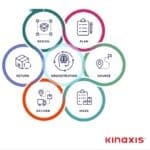Kinaxis is a leading provider of supply chain solutions. Their Kinexions 2024 user conference ended yesterday (June 19th). Like many enterprise application providers, they had a story to tell about artificial intelligence. It is a good story. And a refreshingly honest explanation.
Kinaxis used to refer to itself as a supply chain planning supplier. They are now starting to call themselves a provider of supply chain “orchestration” solutions. A broader term is needed to describe what modern planning solutions can do and, thus, how supply chain processes are changing. I’ll be honest, I’m not sure the term “orchestration” quite captures it.
Newer planning solutions create plans across different planning horizons in a way that they could not in the past. Historically, supply chain execution schedules focused on what would be produced day-by-day or week-by-week in the coming month. Supply chain planning was a month-by-month fulfillment plan that extended out 24 months.
But newer technology is breaking down the borders between planning and execution. If something unexpected occurs and the existing schedule can’t be executed, the planning engine can consider how best to fix material in motion risks. Historically, planning was planning, and execution was execution, and the two solutions did not play well together. John Sicard, the chief executive officer at Kinaxis, defines orchestration as the fusion of planning and execution.
Generative AI is not THE solution to orchestration issues, Kinaxis argues; it is ONE of MANY needed solutions.
Optimization remains a core solution for supply planning. In the broad sense, optimization refers to creating plans that help improve supply chain performance. But in mathematical terms, optimization is a mixed-integer or linear programming approach to finding the best combination of warehouses, factories, transportation flows, and other supply chain resources under real-world constraints.
Often, the one “best” plan cannot be discovered. Instead, a very, very good solution is derived from all the billions of possible plans. The single best solution is not calculated, because fully solving the problem could take weeks or longer. Creating a very good solution in a timely manner is the best that can be done. Historically, optimization was not considered a branch of AI. Now, it is beginning to be included under the AI umbrella.
Supply chain planning, however, has always been more than optimization. Heuristics—a hierarchy of rules—have been used to create some plans where the problem was too complex to optimize. Kinaxis has patents around the combination of heuristics and optimization. This combination limits the solution envelope in a way that allows vastly more options to be considered.
Mathematicians all agree that machine learning is a form of artificial intelligence. On the demand planning side, machine learning has been used for over 20 years to improve forecasts. Machine learning is beginning to improve the master data and parameters that planning engines depend upon.
Yes, Kinaxis executives agree that generative AI can improve supply chain solutions. In particular, GenAI can create user experiences an order of magnitude better than past interfaces. This is important; planning interfaces can be difficult to navigate and use.
But remember, GenAI is built on language models. What GenAI is good at is language, not math.
A good user experience built on top of a bad planning engine just allows a company to do stupid things faster. One executive refers to this as “propagating chaos.” The most important math for supply planning remains optimization. This is an area where Kinaxis excels. Several Kinaxis customers selected the Kinaxis solution, now known as Maestro, because it was better at creating scenarios than other solutions on the market.
When it comes to planning, Kinaxis executives stress that EXPLAINABILITY is critical. Planners need to understand why the engine proposed the recommendations it did. If planners can’t understand the rationale, they won’t use the solution. The new GenAI assistants need to be built to assist with explainability.
Kinaxis’s other focus is increasing the degree of automation in the solution. Mr. Sicard hazarded a guess that 80% of the transactions occurring in a planning engine are safe and obvious. Why should a solution make planners engage in this manual, nonproductive work?
Even the generation of scenarios may be something that, in some cases, can be automated. If a problem arises, and planners always generate one particular scenario to address that problem, why not automate this? This is more complicated than it sounds. But, Andrew Bell, the chief product officer at Kinaxis, believes that within a year or so, Kinaxis can automate some core, repeatable scenarios.
Listening to Kinaxis’s approach to AI was refreshing. I went to another vendor’s conference and saw them demo a solution to a demand spike problem using GenAI that I knew to be impossible. GenAI is not a form of magic that allows time and distance to be erased. This made me doubt much of what I had been told.
Believability, let’s call it “explainability,” was not an issue at Kinexions.
The post Don’t Propagate Chaos with Your Supply Chain Planning System! appeared first on Logistics Viewpoints.
